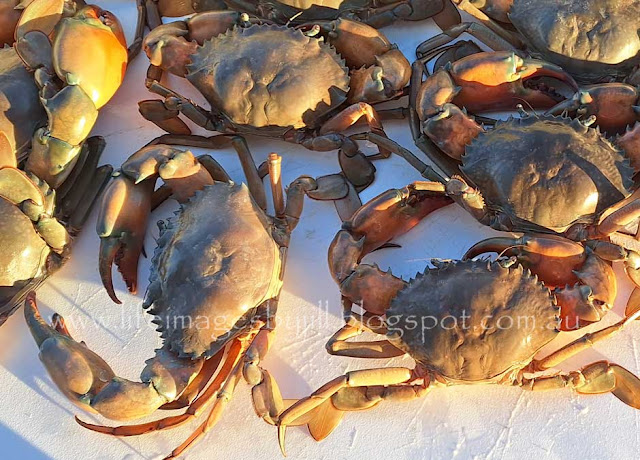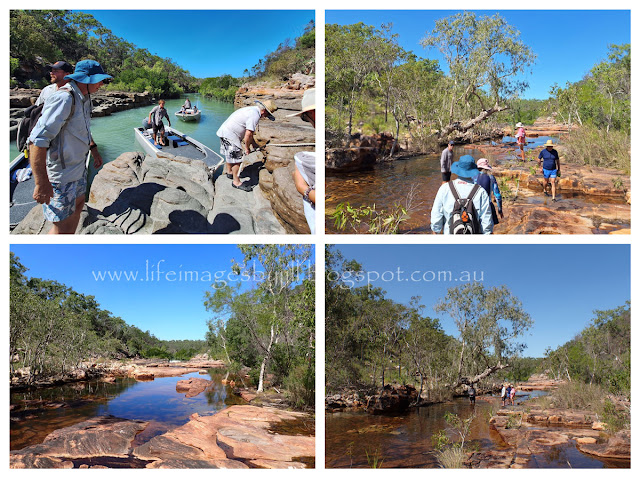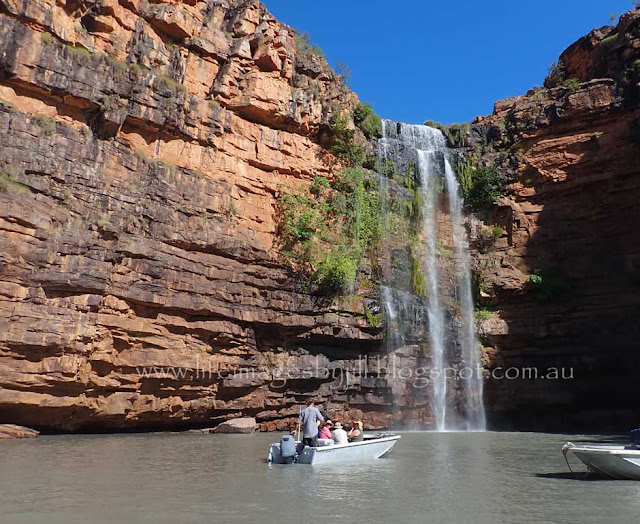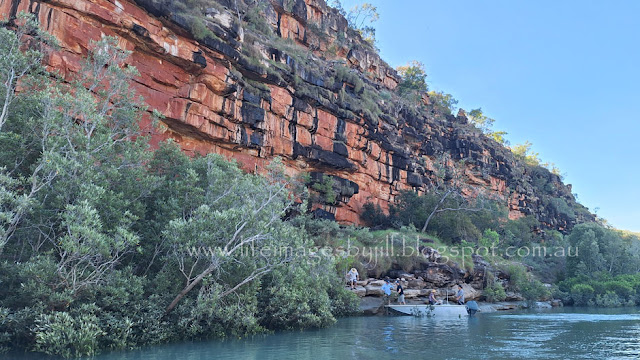Hi everyone, I hope you and yours are dong well. As I sit here on a freezing cold wet day in the south west of Western Australia, I think about our recent Kimberley 9 day cruise on Diversity III and wish I was back there in the warmth and sun with the wonderful group of people we met. So I look at my photos, and try to absorb the warmth, and bring to you Part 3 of my blogs about our amazing bucket-list cruise with Diversity Charters.
If you missed Part 1 and 2 and the Intro - you can catch up with them below here - In these posts I have brought you sunrises and sunsets, boat trips up creeks, walks to swimming holes, thundering waterfalls, ancient aboriginal rock art and fabulous food.
Intro - back from a cruise in the Kimberley
On each day of the cruise we were offered a walk, a swim and a fish. So if you are up to it today I bring you fishing, history, and another delightful swimming hole.
Good morning! - the view from our cabin window. Glorious.
Setting off in the tenders for the day's adventures from Diversity III
Where and when we fish was dependant on the incoming or outgoing tides. Unfortunately our tender didn't catch anything of significance on the afternoon you see below - other than 3 fish for crab bait tomorrow. We flicked our lines into the rock outcrops along the shoreline - being careful not to let it sink as the hook might get caught on the rocks. Flicking, winding in, flicking, winding in. Moving onto another spot for another flick.
One morning we went crabbing for mangrove mud crabs - found in the mangroves and tidal creeks.
Crabbing trips need to be planned around tidal changes, with crabs most active during the incoming tide, when rising water encourages them to forage. The baited crab drop nets were dropped in around the mangroves and tied to trees. Then we went back 20-30 minutes later, and pulled the nets. We also used a landing net under the crab net as often crabs cling to the bottom of the nets and may drop off. We worked in pairs, with Adam our deckie, assisting us. That's me in the floral hat with my partner Marie in the patterned shirt.
I think you could easily get lost in this labyrinth of tidal mangrove creeks.
See those claws? You don't want to stick your hand anywhere near them - as they can take your finger off.
It was a very successful crabbing exhibition, and we had chilli crab for lunch the next day. Most of the meat is in the big claws, and you need a hammer or strong nut cracker to get into them. It is rather tricky and messy!
Below are a couple of pics from another fishing day with Adam - my husband caught a Coral trout and a Queenfish. This day we went trolling for pelagic fish ie - barramundi. You throw out the line with a lure, then the boat moves quietly along, the lure mimicking the movement of a fish.
My husband also got up very early 3 mornings to go fishing before breakfast and caught blue nosed salmon, estuary cod, fingermark bream, and catfish. He was happy with that - however no Barramundi for him unfortunately! I preferred to stay in bed and read my book or sit on the back deck and chat to others who had opted not to go fishing. That is a Coral Trout in the photo below.
Here are some pics from our last fishing afternoon. My husband caught Fingermark bream, estuary cod, honeycomb cod, stripy snapper and I caught a stripy snapper (Spanish flag) and a Mangrove Jack. In the pic you can see my husband with a Fingermark bream and me with a Mangrove jack. Finally I caught a fish! Thank you skipper Mark! Unfortunately not many action photos! All the activity was trying to get the fish into the boat before they jumped off the hook!
Another day the guys had a lesson in how to throw a net off the beach to catch bait. I guess the girls could have had a go, but we were content to slosh in the shallows. Don't go out deep Skipper Mark warned - there might be crocodiles!
We also went oystering off rocks on a beach at Augustus Island. You need a chisel and a hammer. I did eat one off the rocks, but didn't like it - even with a drip of lemon juice over it. At least I can say I tried them. We piled them into an esky with ice to take back to the boat.
We had the oysters for entree that evening - oysters Kilpatrick and battered oysters. I liked the battered oysters.
We also learnt some European history.
We visited Sheep Island and learnt about the failed 1864 Camden settlement where 200 settlers and their families, mainly from Victoria, tried to raise sheep in the harsh Kimberley environment. Arriving in the heat and humidity of December 1864 was probably the worst time to arrive. They transported 4,500 sheep and 36 horses on 3 ships from southern Australia, but lack of freshwater, unsuitable terrain, a harsh climate and trouble with indigenous people, lead to many of the sheep perishing and the settlers eventually abandoned the settlement in October 1865.
The remaining sheep were left at nearby Sheep Island. All that remains today is the headstone of Mary Jane Pascoe who died as a result of childbirth - her child dying a few days later. There are also 6 unmarked graves. A cache at the back of the Boab tree has information about the doomed settlement. There is also more information at: Diving WA Shipwrecks-Camden
In the images below you can see the boab tree, Mary's grave, and Camden land opposite Sheep Island.
We also motored into Careening Bay located in the Prince Regent Nature Reserve (a UNESCO World Biosphere Reserve) and visited the Mermaid Tree to learn the history of British Lieutenant Phillip Parker King who careened his ship, The Mermaid, which was leaking badly, here on 30 September 1820. Repairs took 10 days. This was Kings third voyage of exploration along the Australian coastline.
There are information boards at the site where you can learn more. King was recognized as one of Britain's leading hydrographers and in February 1824 was made a fellow of the Royal Society. You can learn more about King here - Australian Dictionary of Biography
The boab tree you see in the photos below has been engraved with the name Mermaid and the date. King had been instructed by the British Secretary of the State of the Colonies to "leave some evidence which cannot be mistaken of your having landed". In the photo below you can see crewman Tommy telling us about King, and the engraved boab tree.
Want to know more about boabs? They have been scattered through my posts in the past, like here - The-boab-tree-adansonia-gregorii
I didn't have much opportunity for taking wildflower photos during our trip, but here is one of the wild Hibiscus varieties near the Mermaid Tree.
A walk back over the sand to the tenders as the sun drops over the horizon after
I am linking up to the link-ups below. Please click on the links to see fabulous contributions from around the world - virtual touring at its best!




















































